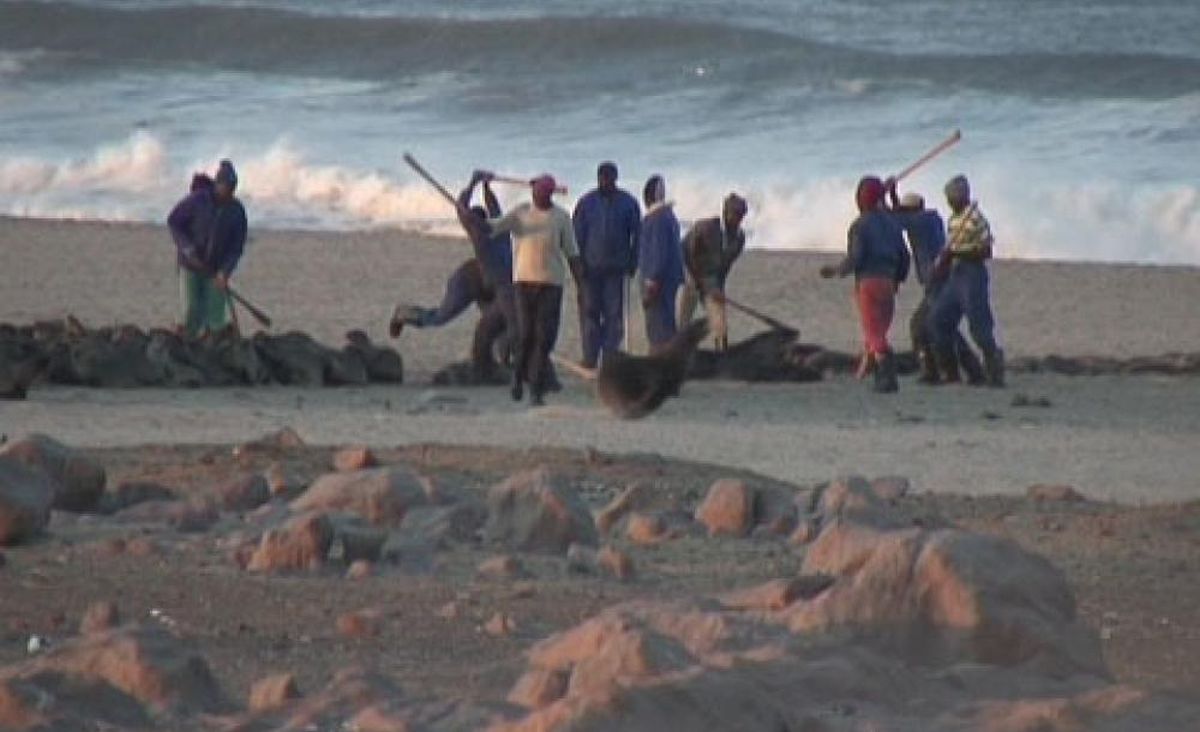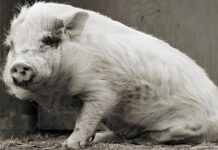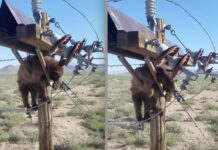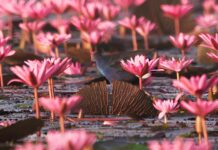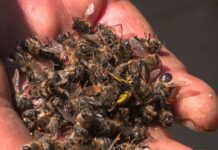Namibia, Canada, and Greenland are the last places where seals are harvested commercially (more than 35 countries have banned products of commercial seal hunts, including the United States, the EU, and Taiwan).
While Canada’s is the world’s largest marine mammal hunt, with some 350,000 harp seals butchered each year, Greenland, where seal hunting is conducted with rifles (the seals are shot in the head from a small open boat while they sit on an ice floe), kills 170,000 seals yearly. Namibia, where seals are listed among the most important commercial marine species, allows the massacre of 80,000 Cape fur seal pups and 6,000 bulls annually.
More than half of southern Africa’s Cape fur seals live in Namibia, with the rest in Angola and South Africa, which banned commercial sealing in 1990. Cape fur seal pups are massacred in Namibia from July to November. They are killed in so-called ‘seal reserves’, beach colonies (along the coast of Namibia: Atlas Bay, Wolf Bay, and Cape Cross) where pups are born and nurse for up to a year. These pups are still nursing when they are forcibly separated from their mothers, corralled in an area of the reserve, and then clubbed and stabbed to death, in the vicinity of their mothers.
The massacre of Cape fur seals is brutal for a number of reasons, including the method of killing and the effect it has on the entire colony. Green World Warriors report:
“The men, who are unskilled, untrained seasonal workers, chase a group of pups away from their mothers and corral them in one area of the beach. The men are supposed to separate a small group of seal pups, but, undercover evidence shows that they often separate and club pups in groups of hundreds, leading to ineffective clubbing and even more suffering for the seals.
“Once the men have a group of seals under their control, they let the group try to escape to the sea while clubbing them. They aim for the seals’ heads and try to stun them. In this panicked scene, with pups crying and terrified, trying to escape, clubbers often miss the seal pup’s head or hit the head with inadequate force to stun the pup. After they stun them, they stab the pups in the heart, still in front of the other pups and near the rest of the colony. Sometimes the pups have not been completely stunned or they regain consciousness as they are being stabbed.”
The seals aren’t threatened with extinction, but, writes the National Geographic, under the Convention on Trade in Endangered Species of Wild Fauna and Flora (CITES), the 183-nation body that regulates international wildlife trade, they’re listed as a species that may become threatened if their trade isn’t closely monitored and controlled.
In 2016, Pat Dickens, the man behind Seals of Nam, a Namibian non-profit aiming to end the country’s sealing industry, initiated an online petition calling for the Cape fur seal trade to be blacklisted because of the inhumane ways seals are killed, the harm harvests do to seal populations, and lack of transparency in the sealing business. The customary way to kill pups is to knock them unconscious with a heavy wooden club, then pierce their main heart vessels with a pick or knife to kill them. But the Cape fur seal is a difficult target.
“Its agility on land means that when you’re taking a swing at it, it takes evasive actions. Clubbing nursing pups in large social colonies is unlikely to be swift and accurate and is extremely stressful,” Dickens says. “Some sealers are migrant workers who are paid a meagre wage and live in makeshift shacks. It’s unlikely, he says, that they’ll have had adequate training in humane killing methods, such as verifying that a seal has been successfully stunned before swiftly piercing its heart vessels.”
In 2010, on the basis of footage of Namibian seal hunts made by filmmaker Bart Smithers, David Lavigne (then science advisor to the International Fund for Animal Welfare) and Stephen Kirkman (a marine scientist for the Oceans and Coasts branch of South Africa’s Department of Environmental Affairs) asserted that the hunts fail to follow the “three-step” killing process.
“Undercover video footage of the hunt at Cape Cross in July 2009, presents clear evidence of hunting regulations being contravened. The footage shows multiple clubbers striking pups within a large group of several hundred animals, contradicting the regulation that only small groups of pups, once they have been released from the large group, may be targeted.
“The purpose of this regulation is to avoid the ineffective stunning of pups that can be expected if attempting to strike individual targets within a dense, teeming mass of seals. Indeed, several instances of mistimed strikes are evident in the footage. Also apparent is that no attempt was being made to monitor and bleed immobilised pups immediately after stunning, as required by the recommended ‘three-step’ killing procedure. Thus, the footage indicates a disregard both of hunting regulations and of humane hunting practices intended to minimise avoidable pain and suffering.”
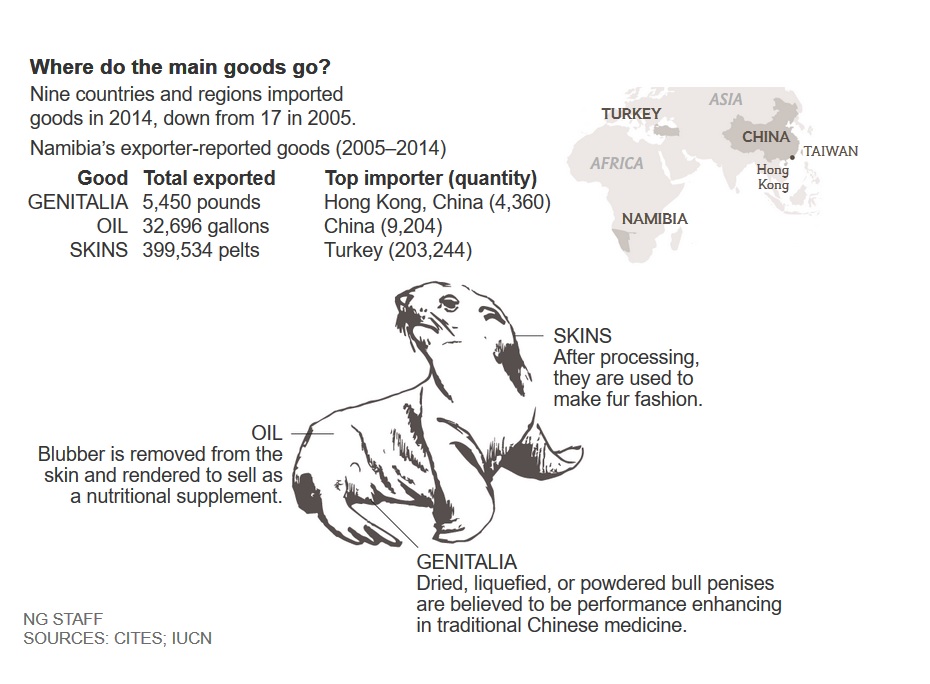
Incidentally, according to Namibia’s 1962 Animal Protection Act, beating or terrifying an animal or causing it suffering is an offense.
How does Namibia’s sealing industry persist in the face of a global trend toward ending the trade?
Hatem Yavuz, a Turkish-Australian fashion mogul, is Namibia’s main sealing concessionaire. According to the National Geographic, he pays royalties to the government for his allotted portion of the annual hunt quota for his fashion line, Fok You (fok means seal in Turkish). He says it takes seven pelts to make a man’s seal coat, which can sell for between $3,000 and $30,000.
Not only for their fur and blubber (which, like harp seal blubber, is sold as a ‘health food supplement’), Cape fur seal bulls are also killed for their genitalia (which are considered aphrodisiacs in parts of Asia). Seal penises are the animal’s most valuable part, selling for approximately $2,000 a pound on average, adds Yavuz.
